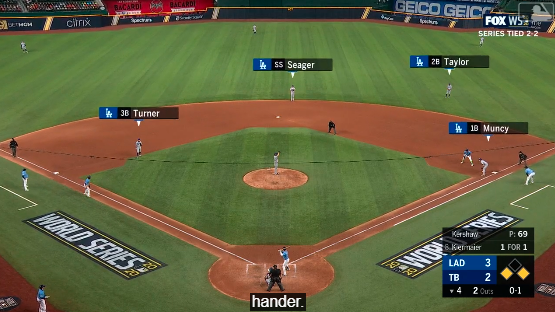Was Margot’s Attempted Steal of Home Justified?

It’s hard to recognize the turning point of a World Series as it’s happening. It’s much easier to look back after it concludes to determine which event was the biggest momentum swing, especially in a frenetic, back-and-forth series like this one. Each game grows in importance, and the Dodgers’ Game Five victory gives them an 81.6 percent chance of winning the championship (as per FanGraphs).
If Game Five indeed becomes the turning point of the series, the most pivotal, memorable play was Manuel Margot’s attempted steal of home in the fourth inning. Tampa Bay trailed 3-2 with two outs and runners on first and third. With the left-handed Clayton Kershaw’s back turned, Margot bolted for home, but was tagged out to end the inning. The Rays failed to score for the rest of the game and lost, 4-2.
Just because Margot was gunned down doesn’t mean it was a bad play. If successful, the score would have been tied, and from there anything could have happened. Just because a gamble loses doesn’t make it a bad bet.
The Situation
A walk is as good as a hit… except when it isn’t. Tying the score would have probably required a base hit by batter Kevin Kiermaier. A free pass would have still been a positive outcome– that would have loaded the bases for Mike Zunino who could plate a run no matter how he reached base– but Kershaw doesn’t often put the eighth and ninth place hitters on base consecutively.
Kiermaier hit just .217 this season, so he’s not the ideal batter in a two-out, runners-in-scoring-position situation. As a left-handed swinger, he was just 3-21 in the regular season against lefty hurlers. Making matters worse, he fouled off the first pitch, falling behind in the count 0-1. Improbably, he actually thrives in this situation throughout his career. He’s a .264 lifetime hitter against lefties after falling behind 0-1 in the count– 16 points higher than his overall career batting average. However, we have to adjust downward for his 2020 season average being below his usual standards, as well as the fact that batting average is calculated based on at bats and not total plate appearances. Altogether, he had roughly a 22.2 percent chance of getting a hit.
We also have to account for the likelihood of Kiermaier passing the baton to Zunino. While his batting average might climb higher in this type of predicament, his on-base percentage takes a downturn. His 0-1 count vs. lefties career OBP is only .286– 21 points worse than his overall career mark. In other words, there’s just a 2.2 percent chance Zunino will come to bat with the bases loaded.
Zunino is a fine player in many respects, but he’s not exactly Tony Gwynn. He slashed just .147/.238/.360 in 2020. Even though he hits right-handed, he was just 1-22 with a pair of walks and a hit-by-pitch against southpaws this year. His career on-base percentage vs. lefties is .273, which is three points above his career mark. Adjust that down for his especially poor 2020 numbers, and we’ll give him a 24.1 percent chance of reaching base somehow and driving in the tying run.
With a 22.2 percent chance of Kieramier getting a hit, a 2.2 percent chance that Zunino will bat with Margot still on third, and a 24.1 percent chance Zunino will come through, there’s just a 24.7 percent overall likelihood that Margot will score… unless he takes matter into his own hands (and legs). If he thought there was at least a one-in-four chance he could swipe home plate successfully, it was a good decision to go for it.
The Play
Margot is a fast dude, ranking 89th percentile in MLB in sprint speed this season. He reached third base to begin with by stealing second, then advancing to third when the throw caromed into right-center field. Here’s the moment before he bolted for home:

That’s about a 25-foot lead on a 90-foot basepath, meaning his dash towards home took just over two seconds before he reached the plate. In those two plus seconds, the Dodgers had to execute several complex maneuvers flawlessly.
First was overcoming surprise. Attempted steals of home are among the rarest events you’ll ever witness in baseball. To wit, Kershaw has only had three runners attempt it against him in 13 MLB seasons and 2,333 regular season innings. It’s almost stupid to expect it; being that vigilant for something that almost never happens probably detracts from concentration elsewhere. They must have reacted unbelievably quickly.
The person in charge of sounding the alarm was first baseman Max Muncy. Since he was holding the runner at first and staring straight towards Kershaw, he had the best vantage of Margot dancing off third. It was his job to yell for the pitcher to throw home immediately. He may not have been directly involved physically, but catching Margot depended entirely on Muncy’s fast reaction and communication.
The next thing that had to happen was Kershaw executing a throw home. Mentally, he was totally unprepared for this. The repetition of pitching mechanics– which he has performed maybe 40,000-50,000 times in life– have to cause a muscular revolt when his brain signals to throw towards home in any other way. It’s foreign and unnatural for pitchers to break with the precision of throwing a pitch, especially so suddenly. This took at least a full second of the two-second timespan the Dodgers had to catch Margot. The throw was a little more up and away from the runner than you’d like, but it got the job done, which is an incredible feat of athleticism.
The final act stars catcher Austin Barnes. Unlike Muncy or Kershaw, he’s well trained for his role. Catchers have to receive a throw and quickly apply a tag to a charging runner all the time– not usually on a steal attempt, but it can’t be too much different than other plays at the plate. The umpire claims he did so just in time. What do you think?

It’s hard to tell if Barnes’ mitt contacted Margot’s arm before his super-extendo sliding glove touched the plate. This was a 50-50 call. Whether the ump ruled him safe or out, a review probably wouldn’t have overturned it.
That was the result of near-perfect execution by Muncy, Kershaw, and Barnes. If any one of them delayed a microsecond longer in their duties, Margot is unquestionably safe. The odds of that are unknown and incalculable, but it’s fair to say the steal attempt had at least a 60 percent chance of success– and probably closer to 70-80 percent, though that’s really just a guess.
Compared with Kiermaier’s and Zunino’s 24.7 percent chance of driving home the tying run in a more conventional manner, Margot’s decision to steal home was more than justifiable. It was the Rays’ best chance to tie the game in that situation. He just missed it by an inch.
















